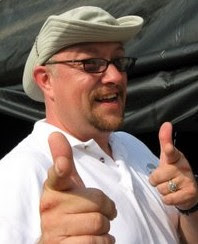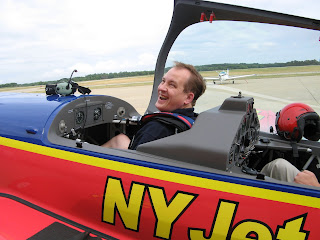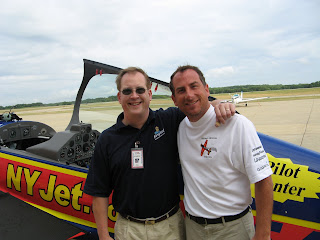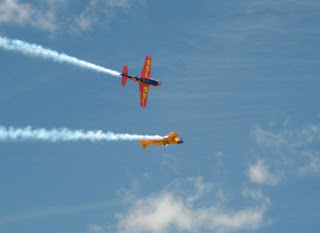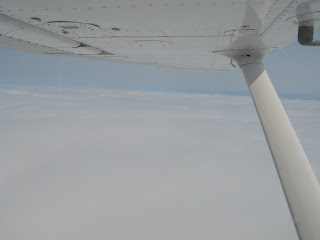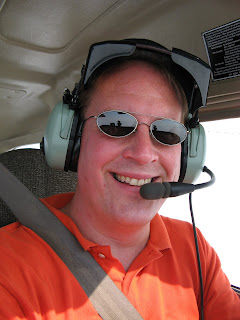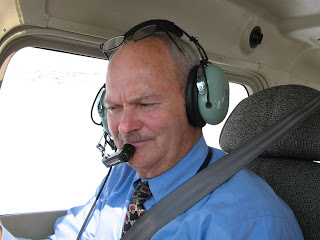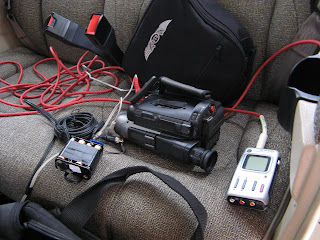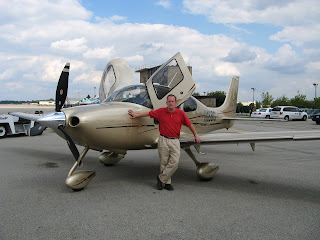
Subscribe to Airspeed through iTunes or your favorite other podcatcher, listen to audio at http://airspeed.libsyn.com/, or download directly at http://media.libsyn.com/media/airspeed/AirspeedCirrusG3Part1.mp3.
Another installment of flying OPA (other people's airplanes)! I took a ride in the Cirrus SR22 GTS Turbo pictured here. Cirrus Design and AirShares Elite attended the annual open house a few weeks ago at my home airport, the Oakland County International Airport (called "Pontiac") (KPTK) and brought along three gorgeous Cirrus SR22s, all with the third-generation technology recently introduced by Cirrus.
I've see the Cirrus display at Pontiac several times, but have always been on duty with the Civil Air Patrol and unable to go try to get a demo flight. But with Cirrus's introduction of the G3 line this year, I decided to make a special effort and drop in on the Friday prior to the open house for a demo ride.
I went with high expectations and I was not disappointed.
You're going to have to listen to the audio of this ride to get the full effect. (See above for the direct link to the audio). It's much easier to listen in to the cockpit conversation and you get a better feel for the experience. That said, here are some highlights.
 It's a gorgeous aircraft and it flies like . . . What the hell does it fly like? How do you explain doing 1.3 Vso banked over 45 degrees and still feeling effective aileron control? Climbing at nearly 1,400 FPM on a warm day with three guys in the aircraft? It's just wonderful.
It's a gorgeous aircraft and it flies like . . . What the hell does it fly like? How do you explain doing 1.3 Vso banked over 45 degrees and still feeling effective aileron control? Climbing at nearly 1,400 FPM on a warm day with three guys in the aircraft? It's just wonderful.
Am I a Cirrus fanboy? Maybe. I'm a C-172 jockey and don't fly a lot of high-performance aircraft. So, in fairness, it's possible that I would have been just as wowed by any high-performance aircraft and that Cirrus has no special sauce. But I think not. The handling, intuitive controls, and responsiveness sure felt special. The airplane just obeyed. Know what I mean?
I concluded long ago that it was unlikely that I would ever launch single-pilot IFR into anything hairier than a 200-foot broken layer. But I could really imagine the SR22 being a genuine go-places airplane that could be a fully-adequate platform for single-pilot IFR, even by a relatively low-time pilot like me. Sure, I'd want to train up and become thoroughly familiar with the systems and maintain currency and proficiency. But the point is that this aircraft made me seriously re-think the idea of single-pilot IFR in the first place. It's that capable and robust. It made me re-think the potential missions that my instrument ticket would open up to me.
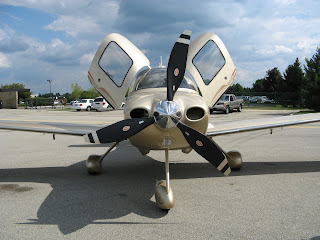 Here's the aircraft from the front. Those gull-wing doors are more than just pretty. They allow the back seat passengers to step from the wing into the rear footwells while still standing up. They need then only sit down and buckle in. No crawling onto the aircraft all bent-over.
Here's the aircraft from the front. Those gull-wing doors are more than just pretty. They allow the back seat passengers to step from the wing into the rear footwells while still standing up. They need then only sit down and buckle in. No crawling onto the aircraft all bent-over.
And the three-bladed composite prop grabs air in front of you and turns it into air behind you efficiently and effectively.
 Gorgeous interior. All white leather. This shot shows the Avidyne glass panels and other avionics. Radios and autopilot are on the center post. Throttle and mix on down by your leg. Side-stick controls are completely intuitive for the yoke-jockey and I can't imagine that stick-and-rudder flyers would have much trouble transitioning.
Gorgeous interior. All white leather. This shot shows the Avidyne glass panels and other avionics. Radios and autopilot are on the center post. Throttle and mix on down by your leg. Side-stick controls are completely intuitive for the yoke-jockey and I can't imagine that stick-and-rudder flyers would have much trouble transitioning.
The flight displays, coupled with the side-stick controls, make the frontal presentation elegant and intuitive. It's like flying your living room. Only the inertial forces are cooler. And the PFD is actually better than my TV.
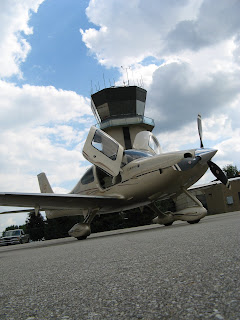 These show notes just scratch the surface. Make sure that you listen to the audio.
These show notes just scratch the surface. Make sure that you listen to the audio.
In addition to this audio, Part 2 will feature an interview with Cirrus co-founder, chairman, and CEO Alan Klapmeier. Look for the episode in a couple of weeks.
Specs (from Cirrus)
Dimensions
Length 26 ft
Height 8 ft 9 in
Wingspan 38 ft 4 in
Cabin Length 130 in
Cabin Width 49 in
Cabin Height 50 in
Design Weights & Loading*
Maximum Gross Weight 3,400 lbs
Standard Empty Weight 2,330 lbs
Useful Load 1,070 lbs
Usable Fuel Capacity 92 gal/552 lbs
* Weights and loading based on base model SR22 Turbo configuration. Actual Useful Loads and individual aircraft weights will vary depending on options installed on aircraft. Always consult specific aircraft weight and balance data for flight planning.
Performance
Takeoff 1,028 ft
Takeoff Over 50 ft Object 1,594 ft
Climb Rate 1,400 ft/min
Max Operating Altitude FL250 (25,000 ft)
Stall Speed with Flaps 60 KCAS
Max Cruise Speed 219 KTAS
Cruise Range w/Reserve (75% pwr) 925 nm
Maximum Range w/Reserve (55% pwr) 1,000 nm
Landing Ground Roll 1,141 ft
Landing Over 50 ft Object 2,344 ft
Engine
Manufacturer Continental
Model IO-550-N
Turbo-normalizing System Tornado Alley
Horsepower 310
Contact Information
Cirrus Design
http://www.cirrusdesign.com/
http://www.cirrusdesign.com/contact/
info@cirrusdesign.com
AirShares Elite
Creig M. Kelley - Regional Director
6230 North Service Road
Waterford, Michigan 48327
Office 248-666-5646
Mobile 989-859-7650
Fax 248-666-5647
ckelley@airshareselite.com
http://www.airshareselite.com/


